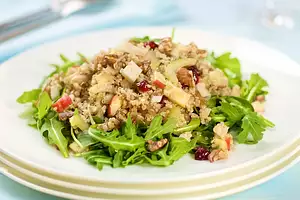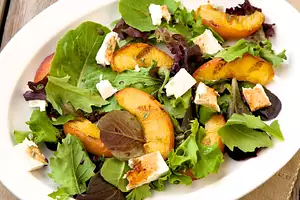Pineapple brings home the flavor of the tropics. It has a mild tang and just the right amount of sweetness to make it delicious in savory or sweet dishes. This tropical fruit is a multiple fruit or composite fruit, made up of many berries that are tightly packed together.
Pineapple is a delicate indulgence when eaten raw, but it is also perfectly suited for grilling, baking, or stir-frying. It pairs well with rice, salads, sauces, or meat dishes. Pineapple can be used to flavor ice creams or sorbets, and its juice adds a unique flavor to smoothies or blended juice drinks.
Pineapples are Packed With Nutrients
One serving of fresh pineapple has 105.1% of the recommended amount of vitamin C! That is more vitamin C than an orange, which only has 92%. The vitamin C in pineapple can protect your body from free radicals which contribute to heart disease, asthma, arthritis, and certain forms of cancer. It also gives you a healthy immune system to protect your body from infection.
Pineapple is excellent for your digestion. The flesh of pineapple is full of Bromelain, although the greatest highest concentration is found in the leaves and core. Bromelain boasts many healthy benefits! It is best known for the enzymes it contains that aid in the digestion of protein. However, bromelain also reduces inflammation and can slow down the growth of specific types of tumors.
Bring Home a Delicious Pineapple
Choose a pineapple that is sure to please by focusing on aroma and appearance. A ripe pineapple should be the color of buttered toast with uniformly-sized eyes from top to bottom. Pick up the pineapple and smell the base. If it smells like pineapple, then it is ripe and ready to eat. If the pineapple has any green areas on the skin, it is not fully ripened. The pineapple should feel firm, without any soft spots. Pineapples do not ripen anymore after they have been picked, so what you see in the store is as good as it will get.
Preparing Your Pineapple
There are tools available in many local grocery stores to help you prepare your pineapple, but all you really need is a sharp knife and a cutting board. Many pineapples come with a tag around the base of the leaves which gives instructions on how to peel, core, and slice the fruit.
Start by removing the leaves. Grasp the leaves with one hand and the pineapple base with the other. Gently twist the leaves and base in opposite directions until the leaves come off in one group. Discard the leaves and get out your cutting board and a sharp knife.
To peel your pineapple, place it on a cutting board with the base resting on the surface of the board. Working carefully, hold the pineapple with one hand as you cut down just inside the skin from top to bottom, removing the skin and eyes completely. Be careful to keep your fingers out of the way. This will get messy and slippery as the pineapple releases its juice.
Sometimes a pineapple will have a few very deep eyes. Instead of hacking into your pineapple and wasting fruit, leave the deep eyes for a moment and cut them out later when you are slicing the pineapple or cutting it into chunks. If your pineapple is large, you could cut it in half and then remove the skin from each half.
The way you remove the core and slice your pineapple all depends on what you will be doing with it. If you want round pineapple disks, you will need to use a pineapple corer to remove the fruit from the core and then you can slice the pineapple into disks. For pineapple wedges or chunks, quarter the pineapple lengthwise. Then, cut into the pineapple on an angle and remove the core from each section. Now you can slice the pineapple into wedges or chunks. Even though pineapple core is just unripened pineapple flesh, it cannot be eaten and should be thrown away.
Storing Your Pineapple
A pineapple is good for up to two days at room temperature or five days in the refrigerator. Plan to eat your pineapple soon after you buy it. Once a pineapple has been prepared, it can be stored in an airtight container in the refrigerator for up to five days. Pineapple fruit does not freeze well.
Recipes:
Sweet:
Fresh Pineapple Upside-Down Cake
Warm PIneapple Mousse with Toasted Shredded Coconut
Grilled Pineapple with Vanilla Coconut Ice Cream & Cacao Nibs
Naturally Sweet Pineapple Muffins
Main Dish :
Pineapple, Olives and Artichoke Heart Pizza
Grilled Chicken with Pineapple Salsa
Jerk Chicken Fajitas with Papaya-Pineapple Salsa
Coconut Shrimp with Calypso Punch Relish
Grilled Rainbow Trout with Apricot Salsa
Salvador Shrimp in Fruit Sauce
Pineapple Brown Sugar Glazed Ham
Side Dish:
Two Onions, Pineapple and Olive Flatbread
Earth Family Roasted Garlic Pineapple Dip
Salad:
Thai Pineapple and Cucumber Salad










Comments